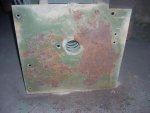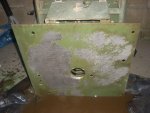I use both the electrolytic method and Evapo-rust. Evapo-rust works great, but is expensive. Electrolytic works great and is cheap, but requires a good electrical connection between all the bits you're trying to derust and the anode source (it's an alkaline system, so you have a sacrificial cathode and the work is the anode). And there has to be line of sight between the rust and the cathode or nothing happens.
So if it's something big and/or simple, I'll hit it with the battery charger and washing soda. I don't even mess with parts like exhaust manifolds anymore until they've been through the soup. Little or complicated things that would be hard to get a good connection to or are just small and fiddly (like special bolts, little brackets, hand tools, Lionel track) go in the evapo-rust.
Caution items:
1. washing soda is mildly caustic. Eye and hand protection are a good idea.
2. Derusted parts (with either method) often have nasty jaggies that will take your hide off or cut you.
3. don't forget about work left in either system - strange chemical stuff starts to happen after a few days.
4. Neither system works
at all if there's anything oily (nonpolar) getting in between the rust remover and the work. Step one, therefore must usually be a thorough degreasing. Again, for big ferrous parts, hot water and lye is very effective, though not exactly danger-free. Also makes a dandy paint stripper.
Useful notes:
1. There are two ways to adjust current flow through the work with an electrolytic system: a) voltage, b) washing soda concentration. This means that you can overload your DC source if you boil off/electrolyze too much water. In either case, you want to start the system with just enough current to cause a gentle bubbling at the electrodes. More is not better - you want just enough gas bubbling to stir the electrolyte.
2. Lye theoretically works better than washing soda in electrolytic derusting, but in practice, it's a don't care. Use washing soda. It's a lot safer.
3. Washing soda can be hard to find. Google for it and you'll find a list of retailers who carry it. It's dirt cheap, btw. I and my motorcycle restorer friend have, however, noticed an alarming tendency for washing soda stocks to be depleted by the laundry department of the household once they discover the stuff. It actually works really well for washing stuff too...
3a. You can get by with dishwasher detergent which is mostly (yup) washing soda. But there's other stuff in there that you may not want. Stick to the very cheapest brand of dishwasher powder to avoid the additives. Even so, it smells funny.
3b. There are also well water treatment systems that use bulk quantities of the stuff to treat acidic well water.
4. Don't put anything aluminum or magnesium in an electrolytic deruster.
5. Evapo-rust also lifts many paints.
6. The electrolyte never wears out in an electrolytic rust remover, but you can get a pretty thick layer of sediment in the bottom of the tank after a while. If your parts sit on the bottom of the (plastic) tank, it can cause electrical problems, too. I pour off the electrolyte, wash the gunk out with a hose, then pour the electrolyte back in.
7. both of these methods have a huge advantage over acids or grinding because they
don't remove any metal. They only remove the rust. This is not an etching process. It can often salvage something like a rusty engine part. Likewise, if you want to see any stampings or makers marks, they're probably still there under the rust. Acid might or might not leave them. A wire wheel would obliterate fine marks. Electrolytic leaves depressions filled in with a thin layer of black magnetite that helps you see them.
And lastly, when in doubt, consult the experts. Here's where I learned about eletrolytic derusting more than a decade ago. These guys do it for a living and they're working with historical treasures that have been soaking in salt water for centuries:
Iron Conservation: Part I - Introduction and Equipment - Conservation Manual - Conservation Research Laboratory - Center for Maritime Archaeology and Conservation - Texas A&M University You're interested in the section on 'electrolytic reduction cleaning.' Note that they get their anode and cathode terms backward because they are archaeologists, not solutions chemists. Also note that they are probably much more worried about chloride (from seawater) than you need to be.




